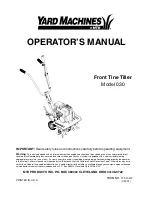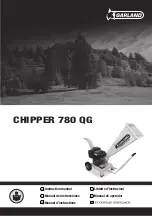
44
Fig. 40 — Motor Housing Temperature Sensors
Checking Pressure Transducers
There are 4 factory-installed pressure transducers measuring re-
frigerant pressure: refrigerant pump suction, bearing inlet pres-
sure, bearing outlet pressure, and economizer vapor discharge
pressure. With the IOB4 option installed there are field options to
install evaporator and condenser entering and leaving pressure
transducers.
These transducers can be calibrated if necessary. It is neces-
sary to calibrate at initial start-up, particularly at high altitude
locations, to ensure the proper refrigerant temperature/pres-
sure relationship. Each transducer is supplied with 5 vdc
power. If the power supply fails, a transducer voltage refer-
ence alarm occurs. If the transducer reading is suspected of
being faulty, check the 5V Sensor Power Monitor voltage. It
should be 5 vdc ± 0.5 v as displayed in
Maintenance Menu
Maintenance Others
, where all the transducer voltages
are shown. Recalibrate and replace the transducer if correct
voltage is being supplied, but displayed values are incorrect.
Additionally, check that any external inputs have not been
grounded.
TRANSDUCER REPLACEMENT
All transducers except the compressor high pressure switch (locat-
ed on discharge pipe) are mounted on Schrader-type fittings.
Transducers installed on Schrader-type fittings can be removed
without the need to remove refrigerant from the vessel when re-
placing the transducers. Disconnect the transducer wiring.
Do not
pull on the transducer wires
. Unscrew the transducer from the
Schrader fitting. When installing a new transducer, do not use pipe
sealer (which can plug the sensor). Put the plug connector back on
the sensor and snap into place. Check for refrigerant leaks.
EVAPORATOR AND CONDENSER PRESSURE TRANS-
DUCER CALIBRATION
Calibration can be checked by comparing the pressure readings
from the transducer to an accurate refrigeration gage read-
ing.These readings can be viewed or calibrated from the HMI
screen. The transducer can be checked and calibrated at 2 pres-
sure points. These calibration points are 0 psig (0 kPa) and be-
tween 25 and 250 psig (173 and 1724 kPa). Connect pressure
transducer to Schrader connection. To calibrate these transducers:
1. Shut down compressor, evaporator, and condenser pumps.
NOTE: There should be no flow through the heat exchangers.
2. Disconnect transducer in question from its Schrader fitting
for evaporator or condenser transducer calibration. For other
pressure or flow device calibration, leave transducer in place.
NOTE: If the evaporator or condenser vessels are at 0 psig (0 kPa)
or are open to atmospheric pressure, the transducers can be cali-
brated for zero without removing the transducer from the vessel.
3. Access the PRESSURE or (if water side pressure)
HYDRAULIC STATUS screen and view the particular trans-
ducer reading. To calibrate pressure or waterside flow device,
view the particular reading. It should read 0 psig (0 kPa). If
the reading is not 0 psig (0 kPa), but within ± 5 psig (35 kPa),
the value may be set to zero from the Maintenance Menu
while the appropriate transducer parameter is highlighted.
The value will now go to zero.
4. If the transducer value is not within the calibration range,
the transducer returns to the original reading. If the pres-
sure is within the allowed range (noted above), check the
voltage ratio of the transducer. To obtain the voltage ratio,
divide the voltage (dc) input from the transducer by the
supply voltage signal or measure across the positive
(+ red) and negative (– black) leads of the transducer. The
input to reference voltage ratio must be between 0.80 and
0.11 for the software to allow calibration. Rotate the
waterside flow pressure device from the inlet nozzle to the
outlet nozzle and repeat this step. If rotating the waterside
flow device does not allow calibration, pressurize the
transducer until the ratio is within range. Then attempt cal-
ibration again.
5. Installation of pressure transducers into water nozzles using
flushable dirt leg trap is suggested; see Fig. 41. Pressures
can be calibrated between 100 and 250 psig (689.5 and
1723.7 kPa) by attaching a regulated 250 psig (1724 kPa)
pressure (usually from a nitrogen cylinder). For calibration,
access the Pressure Sensor Calibration Menu from the
Maintenance Menu and calibrate the appropriate sensor.
Fig. 41 — Suggested Installation of Pressure
Transducers into Water Nozzles Using Flushable Dirt
Leg Trap
The PIC6 control system does not allow calibration if the trans-
ducer is too far out of calibration. In this case, a new transducer
must be installed and re-calibrated.
WARNING
Be sure to use a back-up wrench on the Schrader fitting when-
ever removing a transducer, since the Schrader fitting may
back out with the transducer, causing a large leak and possible
injury to personnel.
SCHRADER VALVE
1/4 NPTF TEE, BRASS
BALL VALVE
TWO (2) 2” PIPE NIPPLES
1/4 - 18 NPT
WATERBOX
NOZZLE
Summary of Contents for AquaEdge 19MV
Page 49: ...49 Fig 46 SIOB...
Page 50: ...50 Fig 47 IOB2...
Page 51: ...51 Fig 48 19MV Auxiliary Controls Wiring...
















































